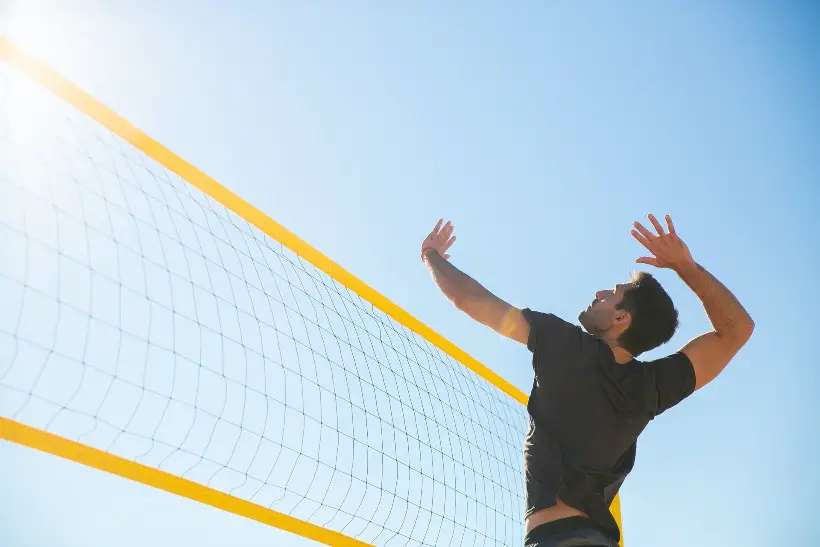
It is not a mystery that to practice volleyball you will need a ball, a net and at least one other player. However, lately while I was browsing some forums and fb groups I’ve seen many people wondering how they can still practice even if they’ve got no ball!
This has sounded interesting as well as challenging for me. I was like “Is that even possible?”
After several weeks of research, I’ve put together this article where I breakdown some helpful tips and ideas for volley drills that doesn’t necessarily require a ball.
Volleyball drills you can do without a ball …
1. Passing
The key to good passing in volleyball is movement as you need to put yourself into the right position for the pass to be accurate, and to get the right pace on the ball, neither too soft nor too heavy.
Steps must be soft and slow and this can be practiced by setting a mark on the court where an imaginary ball is going to land, and perfecting the approach.
At the same time movement must come from your hips, so work on swinging these rhythmically, whilst pushing up with the arms and hands and flexing the fingers, imitating the movement of passing the ball.
Recommendation: This movement and the ones explained below are quite physical and require a high agility. A great way to make those practices easier is to use dedicated shoes. Those volleyball shoes are a great example that you can refer to.
2. Setting
The key to nearly every successful spike is a good set. And a good set is a combination of footwork and the correct positioning of the hands.
Indeed, hands should be raised about six inches above the forehead, with the fingers spread out as if the ball were about to be placed between them.
Meanwhile the feet should be spread about a shoulder’s length apart with the foot closest to the net slightly in front of the other.
The knees should be slightly bent and the weight distributed evenly across the balls of the feet.
Keep in mind that setting a ball without any noise generally means you’ve done a good set!
3. Digging
A dig can be both a defensive and offensive manoeuvre, not only preventing the opposition from scoring, but also help to set up the next attack
Positioning and stance is key, and this can be practiced by standing with the knees bent and with the shoulders in front of the knees. The arms should be held out away from the body.
The distribution of weight is important – a digger should be on their toes so that that spring forward or to either side in order to retrieve the ball.
A player then should stretch their arms outwards, pressed together from hands to elbow, in order to form a platform off which the ball will bounce.
4. Blocking
One of the nest ways for blockers to learn their technique is against a real hitter, and this does not need to involve a ball.
First, they learn how to jump, and focus on their arm and hand positions without worrying about their footwork.
Then they can begin to think about their stance, where to stand, and also begin to gain an understanding of the positioning of their team mates.
Sometimes young players can be put off by the height of the net…
…One way to overcome this problem is to lower it and then gradually raise it again once a player becomes more certain about the basic technique involved in blocking.
5. Serving
Serving can be practiced by imitating the service action!
The correct way to serve is to hold the ball in your less dominant hand in front of the body at waist height. Then with the dominant arm swing towards the hand holding the ball in a swinging motion, bending the lower back and them swinging towards where the (imaginary) ball is being held by the other hand.
Imitate this motion and ensure also that the field are planted behind the service line so that balance and control is maintained. In the follow through sight where on the other side of the net the ball is intended to land.
Serving is one of the most difficult moves to perfect in volleyball, so making the technique as automatic as possible is a great head start.
Could you practice those drills at home?
These drills can be practiced at home provided that here is sufficient space to do so. That is because volleyball is a very physical sport that entails a great deal of movement and the swinging of arms and shoulders.
Those living in apartments or small houses might find themselves banging into furniture or valuable household objects if they practice inside.
However, those who have access to a garden or nearby open space should not have any problems.
Whilst no special equipment is required, it is recommended that people have the right footwear – some of these moves can involve a great deal of wear and tear and normal shoes are not appropriate.
And, as with any sort of exercise, it is always advisable to have a gentle warm-up first.
Going straight into some of the more vigorous moves these drills entail runs the risk of pulled muscle and ache and pains afterwards.
Keep in mind that you can also practice some interesting volleyball drills alone without a wall!
Should you practice those drills as a beginner?
These skills could be practiced as a beginner as far as you practice them properly. Yet, it is probably better to have some ideas of the fundamentals of the game first.
Volleyball can be a difficult sport to learn and understand at the beginning because of its rules and also the different positions and moves.
Trying at too early to improve your techniques in the ways I’ve explained might rob some of the enjoyment from the game when you are just starting to appreciate it.
What are the Benefits of practicing without a ball?
Practicing without a ball will help improve your technique, stance, and overall understanding of the game. Because you will focus on the movement and not the ball. So, once you will practice with the ball, those movements will become pretty much second nature for you.
Removing the ball also helps develop the reading of the game. Defenders can study the arm, body position and approach of an attacker, and communicate with each other what they are seeing.
Attackers can note the position that blockers take at the net, and develop methods to avoid their block.
One more benefit, is that this will help you develop spatial awareness, and an understanding and appreciation of the dimensions of the court, so you will be better able at judging the flight of balls and when they are landing in or are heading over the base or side-lines.
How often should you practice without a ball?
It is recommended that recreational players should practice without a ball once a week, so that they can concentrate on the proper techniques for each of the volleyball skills, such as getting into the right position, focusing on the arm swing, and making sure that the feet are properly planted.
Any more than this and it gets to be counterproductive!
People need time to apply what they have learned in a practice session to a real game situation and it becomes too difficult to keep all this knowledge in the head for an extended period of time.
It also needs to be recognised that practicing without a ball is less enjoyable than with it. When something stops being fun, then it is time to move onto something else.
And obviously, you don’t want this to happen!
More ideas to improve at volleyball with no ball …
1. Watching Games
Watching volleyball games on TV, especially those involving top domestic or international teams is always a valuable experience. Because it shows what the best players are capable of, and the techniques they use.
In particular, it is suggested that attention is paid to what -players do without the ball. Where they stand on court, the positions they take, and how they communicate.
It is often their anticipation and their knowledge of the game that enables them to get into perfect position and stance to execute the next move, or even the one after that.
Absorbing some of these lessons will help you improve your own game!
2. Work on conditioning
Footwork is key in volleyball – – the ability to get to where somebody needs to be on court and to ensure that they are best placed to execute the next shot.
Like everything this can be practiced by a drill that does not involve the ball.
This can be done by taking an athletic stance like a sprinter with the knees bent, as if preparing to receive the ball.
Then put weight on the right foot and jump to the left, landing once more in the stance, which should be held for a minimum of two seconds.
And then change over, beginning by putting the weight on the left foot this time, before jumping to the right.
Repeat the exercise, increase the distance jumped each time. This helps improve balance, stability and ankle strength, all key components of a good volleyball player.
Bottom line
This was my humble take on how you should approach training your volleyball skills and techniques with no ball. Hope you’ve learnt couple new things that you can instantly apply to your own game.
However, I really don’t want you to stress or be too much obsessed by that. Indeed, as I’ve said earlier, practicing those ball-less techniques once a week or once a fortnights is more than enough to get the most out of this.
